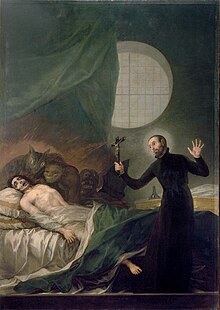
Back Exorcismo en la Iglesia católica Spanish कैथोलिक चर्च में एक्सोर्किज्म HI Pengusiran setan dalam Gereja Katolik ID カトリック教会のエクソシスム Japanese 구마예식 Korean

The Catholic Church authorizes the use of exorcism for those who are believed to be the victims of demonic possession. Initial guidelines were issue in 1614.[1] In Roman Catholicism, exorcism is a sacramental[2][3] but not a sacrament, unlike baptism or confession. Unlike a sacrament, exorcism's "integrity and efficacy do not depend ... on the rigid use of an unchanging formula or on the ordered sequence of prescribed actions. Its efficacy depends on two elements: authorization from valid and licit Church authorities, and the faith of the exorcist."[4] The Catechism of the Catholic Church states: "When the Church asks publicly and authoritatively in the name of Jesus Christ that a person or object be protected against the power of the Evil One and withdrawn from his dominion, it is called exorcism."[3]
The Catholic Church revised the Rite of Exorcism in January 1999.[5] The traditional Rite of Exorcism in Latin remains as an option. The ritual assumes that possessed persons retain their free will, though the demon may hold control over their physical body, and involves prayers, blessings, and invocations with the use of the document Of Exorcisms and Certain Supplications.[citation needed]
Solemn exorcisms, according to the Canon law of the Church, can be exercised only by an ordained priest (or higher prelate), with the express permission of the local bishop, and only after a careful medical examination to exclude the possibility of mental illness.[6] The Catholic Encyclopedia (1908) enjoined: "Superstition ought not to be confounded with religion, however much their history may be interwoven, nor magic, however white it may be, with a legitimate religious rite." Things listed in the Roman Ritual as being indicators of possible demonic possession include: speaking foreign or ancient languages of which the possessed has no prior knowledge; supernatural abilities and strength; knowledge of hidden or remote things which the possessed has no way of knowing; an aversion to anything holy; and profuse blasphemy and/or sacrilege.[citation needed]
- ^ Cite error: The named reference
LiveScience_exorcismwas invoked but never defined (see the help page). - ^ p.43 An Exorcist Tells His Story by Fr. Gabriele Amorth; Ignatius Press, San Francisco, 1999.
- ^ a b Catechism of the Catholic Church, paragraph 1673
- ^ Martin M. (1976) Hostage to the Devil: The Possession and Exorcism of Five Contemporary Americans. Harper San Francisco. Appendix one "The Roman Ritual of Exorcism" p.459 ISBN 0-06-065337-X
- ^ Cite error: The named reference
ContemporaryAmerRelig_exorcismwas invoked but never defined (see the help page). - ^ "THE ROMAN RITUAL Translated by PHILIP T. WELLER, S.T.D." Archived from the original on 2017-08-16. Retrieved 2010-08-27.